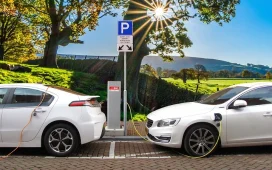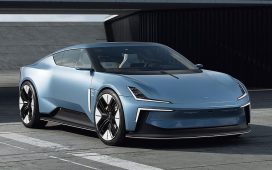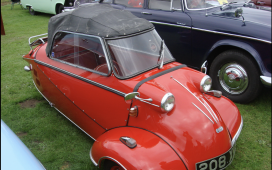The biggest announcement from Chinese brand Zeekr at the Auto China show in Beijing last week looked like a nicely reimagined take on the Multi-Purpose Vehicle. But it was also a sign of the direction of not just Zeekr, but the automotive industry in China in general. It shows just how far the country’s carmakers have come, and how much more competition American and European companies will face from now on.
A Zeekr Mix electric car is displayed at the Auto China show in Beijing on April 25, 2024. (Photo by … [+]
The Mix is of course an electric van, because Zeekr is an electric-only brand. Zeekr hasn’t launched in the USA yet (or the UK) but entered the lucrative European market last year with the 001 shooting brake and X compact car. Since its debut in October 2021, Zeekr has delivered 240,000 vehicles, so not a huge player so far, but it’s also part of massive automotive behemoth Geely, which owns numerous brands only available in China but also Volvo, Lotus, Polestar, LEVC and Malaysian carmaker Proton.
What’s Special About The Zeekr Mix?
Being electric, the Mix has been able to maximize its interior space, as its motors are small and its batteries beneath the floor. However, one of the key design innovations with the Mix is its lack of a B-pillar. On both sides, the front door slides forwards and the rear one backwards. This makes for a wide opening to get into both the front and rear seats of the car. In the prototype demo vehicle, there was a table in the middle and the front seats could rotate, turning the car interior into a dining area.
The idea is that this is a perfect format for families on a day out. Now that China is more affluent, its people are looking for better ways to enjoy their leisure time, so vehicle designs are starting to be oriented more towards this than being purely utilitarian. At the Auto China show, there were quite a few vehicles on display with bicycle racks or offroad-focused cars aimed at exploring China’s immense countryside. Design studies of the Mix also showed it as a camper van.
The Zeekr Mix appears to lack a B-pillar (Photo by Pedro PARDO / AFP) (Photo by PEDRO PARDO/AFP via … [+]
It might be a cause for concern that the Mix has no B-pillar, but that’s not entirely true. The edges of the doors are strengthened with built-in pillars, so when the doors lock into place, they actually form a B-pillar. The design still needs to go through independent safety testing to certify this system works, because this is not a production vehicle yet (and Zeekr didn’t say when it would be other than “soon”) but it’s a very clever piece of engineering. Zeekr expects a five-star safety rating globally when the Mix enters the market.
From MPV To Robotaxi
However, this doorway innovation is not the most important implication of the Mix design. The Mix arrives as the first example of a new variant of Zeekr’s SEA (Sustainable Experience Architecture) platform called SEA-M. This version is meant for MPVs, logistics vehicles and “robotaxis”, which are self-driving passenger transport. Although Zeekr has chosen the Mix, a lifestyle family vehicle, to debut the SEA-M platform, autonomous driving is a clear focus for the company and its parent Geely.
At Auto China Beijing, another Geely brand, JiYue, was showing off its self-driving capabilities alongside the launch of a new vehicle called the 07 (Geely cars tend to have numbers rather than names, so the Mix is a bit of an outlier). JiYue is co-owned with Baidu (which has a 35% share compared to Geely’s 65%), the huge Internet services company that provides the most sophisticated and comprehensive street mapping of China.
At the time of writing, JiYue had a promotion offering its self-driving software, called Point to Point Autopilot (PPA), for free with its vehicles, although once this is over it will cost 49,900 RMB ($7,000). This is essentially a Level 3 system, although technically not yet licensed at this level due to regulatory restrictions. At Auto China Beijing, I was treated to a demonstration of its abilities, which JiYue claims will be available in 200 Chinese cities by the end of 2024. It’s not quite truly point-to-point yet – the driver had to control the JiYue 01 demo car away from my hotel and through a few side roads to the nearest major road before PPA could be enabled. But after that it did a pretty incredible job.
JiYue’s PPA navigates highway conditions extremely well.
It’s a camera-based system like Tesla Vision, although JiYue also uses radar information as a safety backup. Unlike Tesla’s Navigate on Autopilot, though, PPA will change lanes automatically to overtake slower vehicles in the current lane, rather than just suggesting these moves. It can of course steer and control speed based on the road and the cars around it. PPA also automatically gets in the correct lane for a junction and then joins the slip road for you. It will stop at red traffic lights and then start again when they go green.
The most incredible feat it performed during my test drive was joining a highway from a side road that had no traffic signals. This junction included cars, scooters and bicycles coming from the left, plus pedestrians going in both directions. PPA waited for a safe point to proceed, and at no point felt like it would endanger the vulnerable other road users. You could see them all rendered in 3D on the dashboard, showing the system had detected them correctly.
The word “robotaxi” was frequently to be heard at Auto China – something Elon Musk has also been talking about as the main focus of Tesla going forward instead of the small “$25,000 Tesla” that we had been expecting from the company by now. There are already limited trials of this kind of technology in China, such as AutoX’s system in Shenzhen. Chinese companies seem much more bullish about the idea than anywhere else in the world.
China’s Autonomous Challenge To Global Automakers
Zeekr also plans to offer similar capabilities to PPA via its M-Vision software for the Mix. It’s not a huge leap to imagine a Level 4 autonomous Mix with the occupants sitting facing each other round a table as their vehicle drives itself to their destination. Or businesspeople having an in-person meeting as they travel. In fact, Zeekr partnered with Waymo to create the first dedicated Waymo One vehicle designed to be “for riders first”, using a design with an uncannily resemblance to the Mix.
Zeekr also created a dedicated self-driving taxi for Waymo.
This is clearly the overall vision of Geely, and several other automotive brands in China, such as XPeng. Judging by my experience of JiYue’s PPA, they’re closer to realizing this goal than European automakers. Even Tesla’s FSD, while having more city capabilities, won’t be available in as many locations as PPA will be by 2025. This should be a wakeup call for the rest of the automotive industry. Where autonomous technology is concerned, China’s carmakers might just be making a great leap forward ahead of the global competition.






